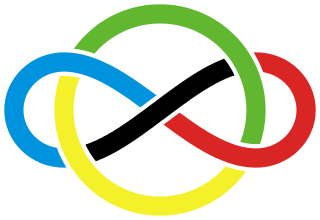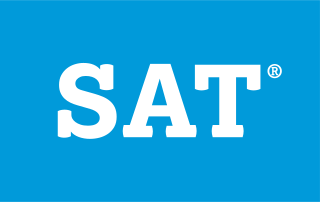
The International Mathematical Olympiad (IMO) is a mathematical olympiad for pre-university students, and is the oldest of the International Science Olympiads. It is one of the most prestigious mathematical competitions in the world. The first IMO was held in Romania in 1959. It has since been held annually, except in 1980. More than 100 countries participate. Each country sends a team of up to six students, plus one team leader, one deputy leader, and observers.

The SAT is a standardized test widely used for college admissions in the United States. Since its debut in 1926, its name and scoring have changed several times. For much of its history, it was called the Scholastic Aptitude Test and had two components, Verbal and Mathematical, each of which was scored on a range from 200 to 800. Later it was called the Scholastic Assessment Test, then the SAT I: Reasoning Test, then the SAT Reasoning Test, then simply the SAT.
The United Kingdom Mathematics Trust (UKMT) is a charity founded in 1996 to help with the education of children in mathematics within the UK.

Multiple choice (MC), objective response or MCQ is a form of an objective assessment in which respondents are asked to select only correct answers from the choices offered as a list. The multiple choice format is most frequently used in educational testing, in market research, and in elections, when a person chooses between multiple candidates, parties, or policies.
The American Mathematics Competitions (AMC) are the first of a series of competitions in secondary school mathematics that determine the United States of America's team for the International Mathematical Olympiad (IMO). The selection process takes place over the course of roughly five stages. At the last stage, the US selects six members to form the IMO team. The 1994 US IMO Team is the first of the only two teams ever to achieve a perfect score (all six members earned perfect marks), and is colloquially known as the "dream team".

The American Regions Mathematics League (ARML), is an annual, national high school mathematics team competition held simultaneously at four locations in the United States: the University of Iowa, Penn State, University of Nevada, Reno, and the University of Alabama in Huntsville. Past sites have included San Jose State University, Rutgers University, UNLV, Duke University, and University of Georgia.

Mu Alpha Theta (ΜΑΘ) is the United States mathematics honor society for high school and two-year college students. In June 2015, it served over 108,000 student members in over 2,200 chapters in the United States and in 20 foreign countries. Its main goals are to inspire keen interest in mathematics, develop strong scholarship in the subject, and promote the enjoyment of mathematics in high school and two year college students. The name is a rough transliteration of math into Greek. Buchholz High School won first place in 2022 for the 14th time in the annually held national convention.
Advanced Placement (AP) Chemistry is a course and examination offered by the College Board as a part of the Advanced Placement Program to give American and Canadian high school students the opportunity to demonstrate their abilities and earn college-level credit. AP Chemistry has the lowest test participation rate, with around half of AP Chemistry students taking the exam.
The Texas Math and Science Coaches Association or TMSCA is an organization for coaches of academic University Interscholastic League teams in Texas middle schools and high schools, specifically those that compete in mathematics and science-related tests.
The Australian Mathematics Competition is a mathematics competition run by the Australian Maths Trust for students from year 3 up to year 12 in Australia, and their equivalent grades in other countries. Since its inception in 1976 in the Australian Capital Territory, the participation numbers have increased to around 600,000, with around 100,000 being from outside Australia, making it the world's largest mathematics competition.
Advanced Placement (AP) Statistics is a college-level high school statistics course offered in the United States through the College Board's Advanced Placement program. This course is equivalent to a one semester, non-calculus-based introductory college statistics course and is normally offered to sophomores, juniors and seniors in high school.
This article describes the selection process, by country, for entrance into the International Mathematical Olympiad.
Math wars is the debate over modern mathematics education, textbooks and curricula in the United States that was triggered by the publication in 1989 of the Curriculum and Evaluation Standards for School Mathematics by the National Council of Teachers of Mathematics (NCTM) and subsequent development and widespread adoption of a new generation of mathematics curricula inspired by these standards.
HMMT is an annual high school math competition that started in 1998. The location of the tournament, in Cambridge, Massachusetts, alternates between Harvard University and MIT. The contest is written and staffed almost entirely by Harvard and MIT students.
In the U.S., the SAT Subject Test in Mathematics Level 2 was a one-hour multiple choice test. The questions covered a broad range of topics. Approximately 10-14% of questions focused on numbers and operations, 48-52% focused on algebra and functions, 28-32% focused on geometry, and 8-12% focused on data analysis, statistics and probability. Compared to Mathematics 1, Mathematics 2 was more advanced. Whereas the Mathematics 1 test covered Algebra II and basic trigonometry, a pre-calculus class was good preparation for Mathematics 2. On January 19, 2021, the College Board discontinued all SAT Subject tests, including the SAT Subject Test in Mathematics Level 2. This was effective immediately in the United States, and the tests were to be phased out by the following summer for international students. This was done as a response to changes in college admissions due to the impact of the COVID-19 pandemic on education.
Number Sense is one of several academic events sanctioned by the University Interscholastic League. It is also a competition held by the Texas Math and Science Coaches Association, using the same rules as the UIL. It is one of the UIL's oldest academic competitions: the first state title was awarded in 1943.
Calculator Applications is one of several academic events sanctioned by the University Interscholastic League (UIL) in Texas, USA. It is also a competition held by the Texas Math and Science Coaches Association, using the same rules as the UIL.
In the US state of Texas science is one of several academic events sanctioned by the University Interscholastic League. It is also a competition held by the Texas Math and Science Coaches Association, using the same rules as the UIL.
Mathematics is one of several academic events sanctioned by the University Interscholastic League. It is also a competition held by the Texas Math and Science Coaches Association, using the same rules as the UIL.
The Intermediate Math League of Eastern Massachusetts is a math league for middle schools across Eastern Massachusetts. A brief history of IMLEM is given in its By-Laws:
The first contest of the Intermediate Math League was held in March, 1965. This meeting was viewed as an experiment to determine the advisability of this type of academic competition for the age levels of students in grades 7 through 9. Enthusiasm and commitment to the contest idea spread quickly. Throughout the years, the League has grown in membership from ten to forty three schools. Students have the honor of representing their school in an academic competition, while interacting academically and socially with students from other communities. Advisors have the opportunity to discuss and compare their programs in mathematics. In 1986, the academic competition was redesigned to accommodate the regional change from junior high schools to middle schools. Teams then consisted of students in grades 7 and 8. Sixth grade students were allowed to participate as seventh graders.





